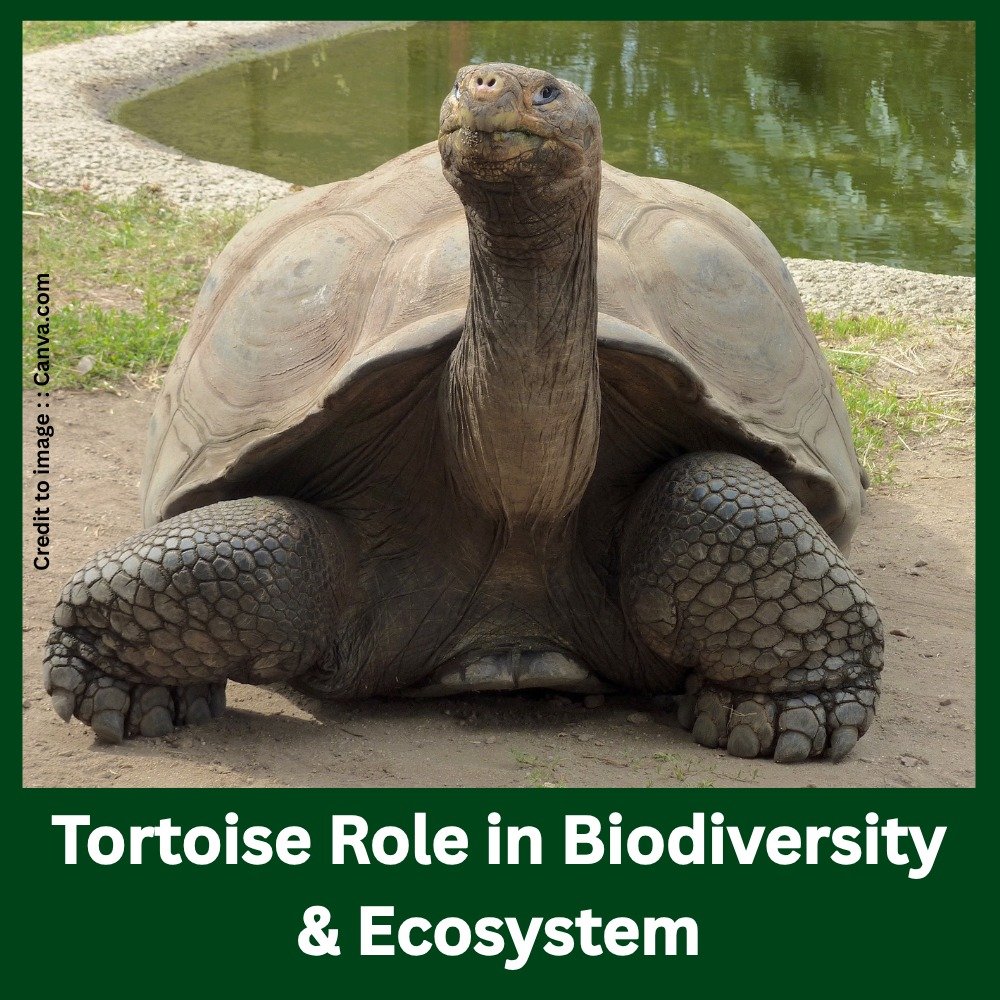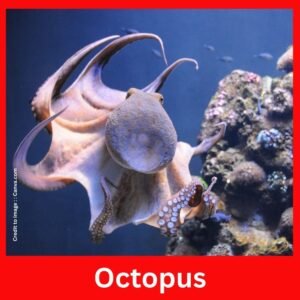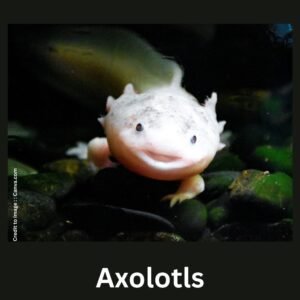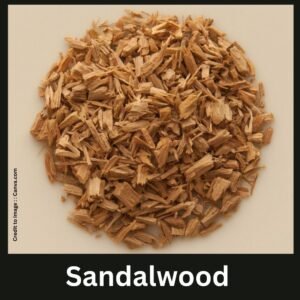Tortoises are long-living, terrestrial reptiles that play a crucial ecological role in arid and semi-arid ecosystems. With their slow movement and extended lifespans, tortoises symbolize patience, endurance, and environmental balance. Article “Tortoise Role in Biodiversity & Ecosystem Health, Lifespan, Conservation, Species “ explores the biological traits, global diversity, conservation status, ecological significance, and scientific data on tortoises. It also highlights their importance in biodiversity conservation and links their protection with Sustainable Development Goals (SDGs). By presenting scientific insights, frequently asked questions, and a call to action.
This article invites researchers, students, and conservation enthusiasts to understand and advocate for tortoise conservation, and encourages publishing research in Prakriti Darshan – Nature and Environment Journal.
Table of Contents : Tortoise Role in Biodiversity & Ecosystem Health, Lifespan, Conservation, Species
- Introduction
- Scientific Classification of Tortoise
- Unique Features of Tortoises
- Global Diversity and Species Distribution
- Tortoise Role in Biodiversity & Ecosystem
- Conservation Status and Threats
- Tortoises and Sustainable Development Goals (SDGs)
- Scientific Data Tables
- Mythology About Tortoise & Protection Act
- Summary
- Conclusion
- FAQs (15+)
- References
- Appeal to Researchers and General Readers
1. Introduction :Tortoise Role in Biodiversity & Ecosystem Health
The tortoise, a member of the Testudinidae family, is a land-dwelling reptile known for its hard shell and remarkable lifespan. Tortoises differ from turtles in a few key ways—they live entirely on land, have high, dome-shaped shells, and walk on sturdy, column-like legs. Around the world, scientists are paying growing attention to tortoises for the quiet but crucial roles they play: loosening soil as they move and dig, spreading seeds through their diet, and offering valuable clues about the health of their ecosystems. Conservation biologists and wildlife ecologists consider tortoises to be keystone species in several ecosystems, including deserts, grasslands, and savannahs. The need for robust conservation efforts is vital, as many species are endangered due to habitat loss, poaching, and climate change.
2. Scientific Classification of Tortoise
| Taxonomic Rank | Classification |
| Kingdom | Animalia |
| Phylum | Chordata |
| Class | Reptilia |
| Order | Testudines |
| Family | Testudinidae |
| Common Name | Tortoise |
| Distinction | Terrestrial turtle with dome shell |
3. Unique Features of Tortoises
- Long Lifespan: Some species like the Aldabra giant tortoise can live over 150 years.
- Slow Metabolism: Helps them survive with less food and water.
- Protective Shell: The tortoise’s hard outer shell—made up of the carapace on top and the plastron underneath—acts like natural armor, shielding it from predators and environmental threats.
- Herbivorous Diet: Mostly eat grass, leaves, flowers, and fruits.
- Adaptable Nature: Tortoises are remarkably resilient creatures, capable of thriving in a variety of environments including arid deserts, dry grasslands, and lush tropical landscapes.
4. Global Diversity and Species Distribution
| Region | Common Species | Conservation Status |
| Galápagos Islands | Galápagos Giant Tortoise (Chelonoidis nigra) | Endangered |
| Africa | Leopard Tortoise (Stigmochelys pardalis) | Least Concern |
| Asia (India) | Indian Star Tortoise (Geochelone elegans) | Vulnerable |
| Seychelles | Aldabra Giant Tortoise (Aldabrachelys gigantea) | Near Threatened |
| North America | Desert Tortoise (Gopherus agassizii) | Threatened |
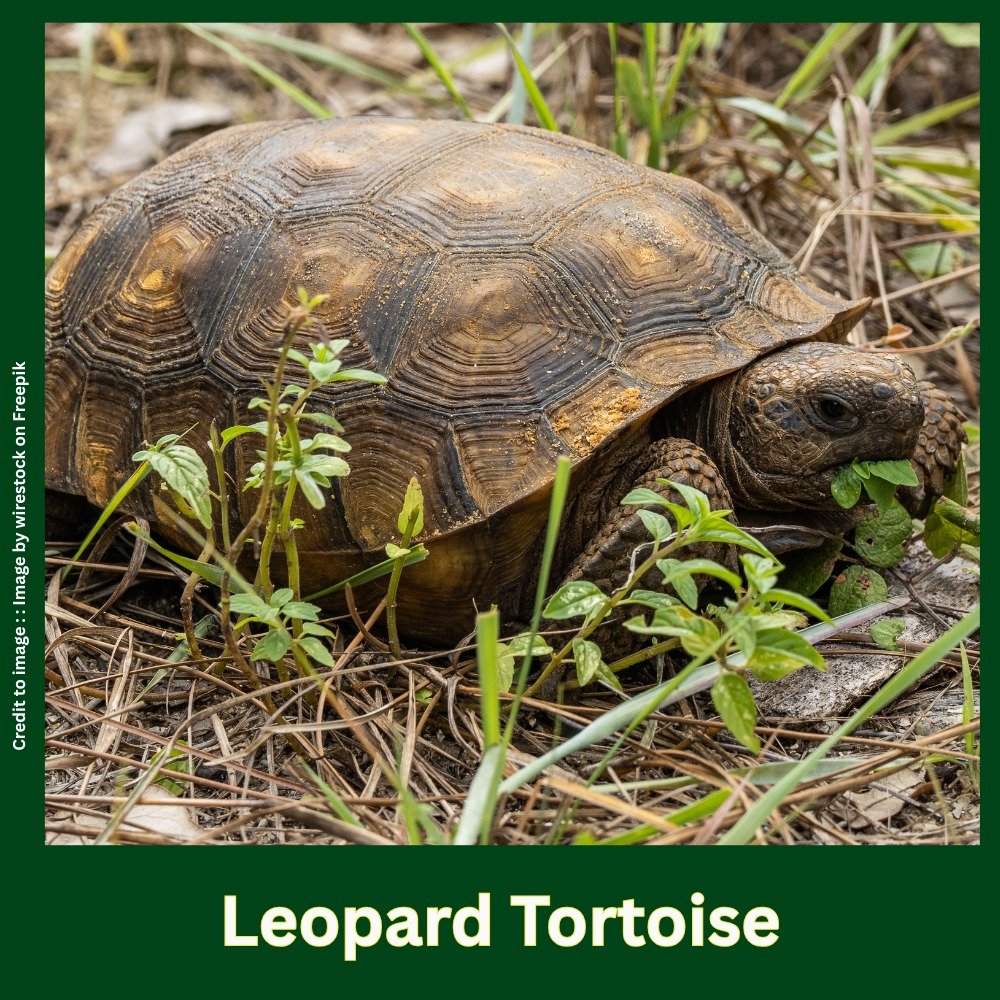
5. Tortoise Role in Biodiversity & Ecosystem
Tortoises are not just slow-moving reptiles with long lifespans—they are ecosystem engineers and keystone species that play a vital role in maintaining the balance of biodiversity and ecological health. From deserts to grasslands, tortoises help shape their environments in quiet but powerful ways.
A. Seed Dispersal and Plant Diversity
Tortoises are herbivores that consume a wide variety of grasses, fruits, and leaves. As they move through their habitats:
- As tortoises feed on various plants, they consume seeds along the way.
- Later, they release these seeds through their droppings, often at a distance from where they were first eaten, helping new plants grow in different areas.
- This helps in natural reforestation and genetic dispersal of flora across wide areas.
Result:
Tortoises enhance plant biodiversity. Promote healthy regeneration of ecosystems which important for all .
B. Soil Aeration and Habitat Creation
Many tortoise species, especially those in arid regions like the Desert Tortoise (Gopherus agassizii), dig burrows to escape extreme weather.
- Their burrows naturally loosen the soil, enhancing airflow and helping rainwater soak in more effectively.
- After being abandoned, they become refuges for other species such as snakes, rodents, lizards, and insects.
Tortoise burrows = Biodiversity shelters
C. Nutrient Cycling
Tortoises contribute to ecosystem nutrient balance:
- By feeding on fallen leaves and decaying vegetation, they help break down organic matter.
- Their droppings act as natural fertilizer, returning essential nutrients to the soil.
They are small-scale recyclers that help keep nutrient cycles intact.
D. Keystone Species in Fragile Ecosystems
In places like dry forests, islands, and deserts, tortoises play a much bigger role than their slow pace might suggest. They’re considered keystone species—their presence shapes the entire ecosystem, supporting a wide range of plants and animals that rely on the balance they help maintain.
For example:
- The Aldabra Giant Tortoise helps keep invasive plants in check on its island habitat.
- In its absence, invasive species can overtake native plants, collapsing the delicate ecosystem.
E. Indicators of Ecosystem Health
Tortoises are sensitive to environmental changes like:
- Habitat loss
- Climate fluctuations
- Water scarcity
- Pollution
A decline in tortoise populations often signals deeper ecological problems in the habitat.
Tortoises as bioindicators can help scientists and conservationists monitor ecosystem health.
F. Role in Conservation and SDGs
Protecting tortoises directly contributes to:
- ✅ SDG 15: Life on Land
- ✅ SDG 13: Climate Action
- ✅ SDG 12: Responsible Consumption
- ✅ SDG 4: Education for Sustainability
Tortoises are flagship species—by conserving them, entire habitats and species communities are protected.
Conclusion
Tortoises may live quietly in the background, but their role in maintaining biodiversity and healthy ecosystems is loud and clear. As burrowers, seed carriers, nutrient cyclers, and habitat creators, these gentle reptiles are ecological guardians.
Protecting tortoises means protecting the web of life they support.
6. Conservation Status and Threats
| Threat Factor | Impact Level | Explanation |
| Habitat Destruction | Very High | Urbanization, agriculture, mining |
| Illegal Wildlife Trade | High | Collected for pets, rituals |
| Climate Change | Moderate to High | Alters nesting and food cycles |
| Predation of Eggs | Moderate | By invasive species like rats |
| Road Mortality | Localized | Deaths during migrations |
7. Tortoises and Sustainable Development Goals (SDGs)
- SDG 15 – Life on Land: Tortoise conservation aligns directly with habitat preservation.
- SDG 13 – Climate Action: Tortoises serve as climate indicators for dry ecosystems.
- SDG 12 – Responsible Consumption: Curbing pet trade promotes sustainable wildlife ethics.
- SDG 4 – Quality Education: Conservation education creates awareness about endangered species.
8. Scientific Data Tables
Lifespan of Major Tortoise Species
| Species | Average Lifespan (Years) |
| Galápagos Giant Tortoise | 100–120 |
| Aldabra Giant Tortoise | 80–150 |
| Indian Star Tortoise | 35–80 |
| Desert Tortoise | 50–80 |
Shell Dimensions & Weight Range
| Species | Average Shell Length | Weight Range |
| Galápagos Tortoise | 100–130 cm | Up to 250 kg |
| Indian Star Tortoise | 20–30 cm | 2–7 kg |
| Leopard Tortoise | 40–70 cm | 18–40 kg |
| Aldabra Giant Tortoise | Average Shell length 90–120 cm | Weight Up to 250 kg |
Population Estimates (Approx.)
| Species | Estimated Population | Source |
| Galápagos Tortoise | ~15,000 | IUCN, 2024 |
| Aldabra Tortoise | ~100,000 | Seychelles NPA |
| Indian Star Tortoise | Declining | CITES, 2023 |
| Desert Tortoise (USA) | ~200,000 | USFWS, 2023 |
Star Tortoise (General Overview)
The Star Tortoise refers to a group of tortoises known for the striking star-like radiating patterns on their shells. The most well-known among them is the Indian Star Tortoise (Geochelone elegans), native to India and Sri Lanka. This tortoise gets its name from the yellow or light-colored star-like patterns against a dark brown or black shell, which serve as camouflage in dry grasslands and scrub forests.
Key Characteristics:
- Size: 7–12 inches in length.
- Weight: 1–2.5 kg.
- Diet: Herbivorous— fruits, grasses, cactus pads, and vegetables etc .
- Lifespan: 35 years to 80 years lifespan of this species .
- Habitat: Dry areas like scrublands, semi-arid forests, and grasslands.
Conservation Status:
- IUCN Red List: Vulnerable
Threats:
- Illegal pet trade practice , habitat loss, and forest degradation etc are threats .
Red-Eared Slider Tortoise (Trachemys scripta elegans)
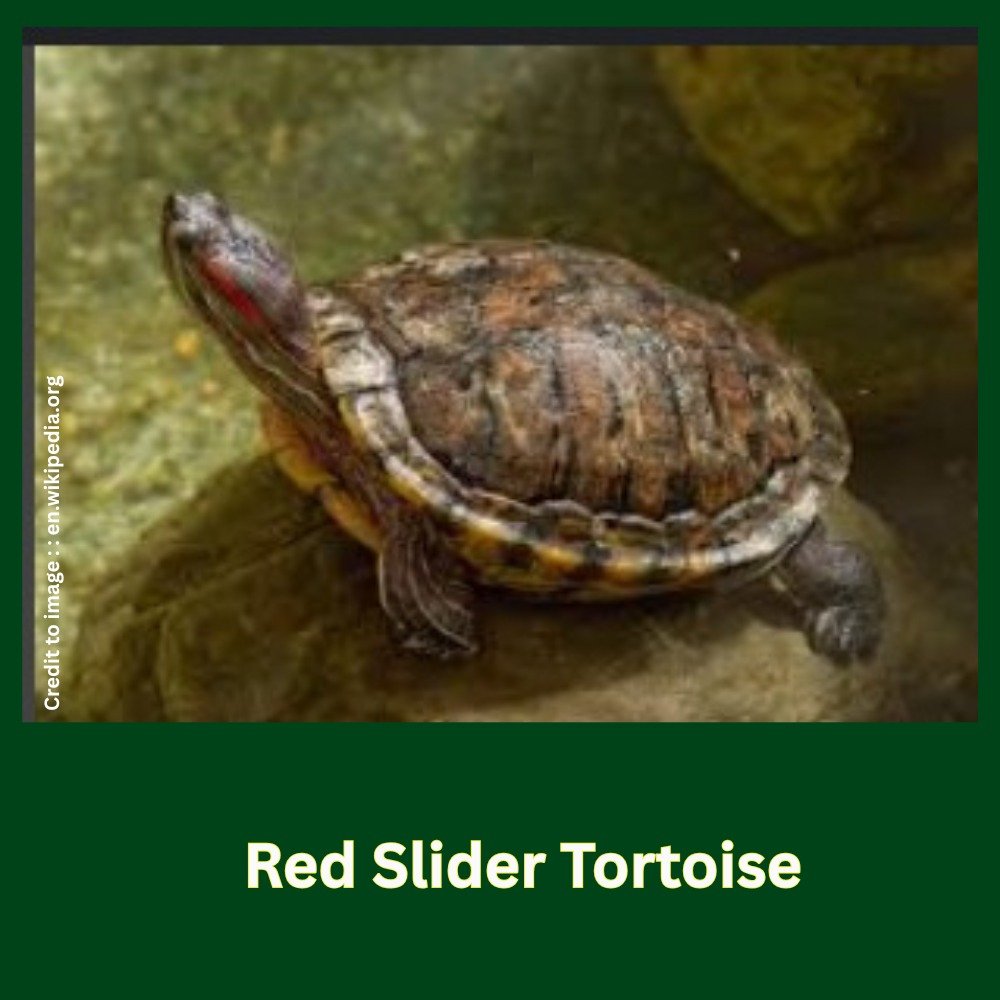
The Red-Eared Slider, often mistakenly called a “tortoise,” is actually a semi-aquatic freshwater turtle native to the southern United States. It is one of the most popular pet turtles worldwide.
Key Characteristics:
- Identification: Recognizable by the red stripe behind each eye.
- Size: Approx size is 6–12 inches in length.
- Lifespan: 20 years to 30 years in lifespan .
- Habitat: Freshwater ponds or lakes, and slow-moving rivers.
- Diet: Omnivorous – aquatic plants, insects, fish, and turtle pellets.
Ecological Impact:
- Considered invasive in many countries like India, Japan, and Australia due to pet releases.
Legal Status in India:
- Tortoise is not native to India .Discouraged as pets due to environmental risks.
Turtle vs. Tortoise: Key Differences
While turtles and tortoises both belong to the order Testudines, they differ in several biological and ecological aspects. Here’s a comparison:
| Feature | Tortoise | Turtle |
| Habitat | Terrestrial (land-dwelling) | Aquatic or semi-aquatic (water-dwelling) |
| Shell Shape | Dome-shaped and heavy | Flat and streamlined |
| Feet | Elephant-like, sturdy legs | Webbed feet or flippers for swimming |
| Diet | Mostly herbivorous | Omnivorous (varies by species) |
| Lifespan | Longer (50–150 years) | 20–50 years |
| Movement | Slow-moving | Faster in water |
| Example | Indian Star Tortoise | Red-Eared Slider Turtle |
Key Point:
Tortoises are adapted for life on land, while turtles are suited for life in water.
Indian Star Tortoise (Geochelone elegans)
The Indian Star Tortoise is naturally found in India. Also found in near country Sri Lanka, and western regions of Pakistan. Where it inhabits dry forests and scrublands. Its attractive shell pattern makes it a target in the illegal pet trade, despite its conservation status.
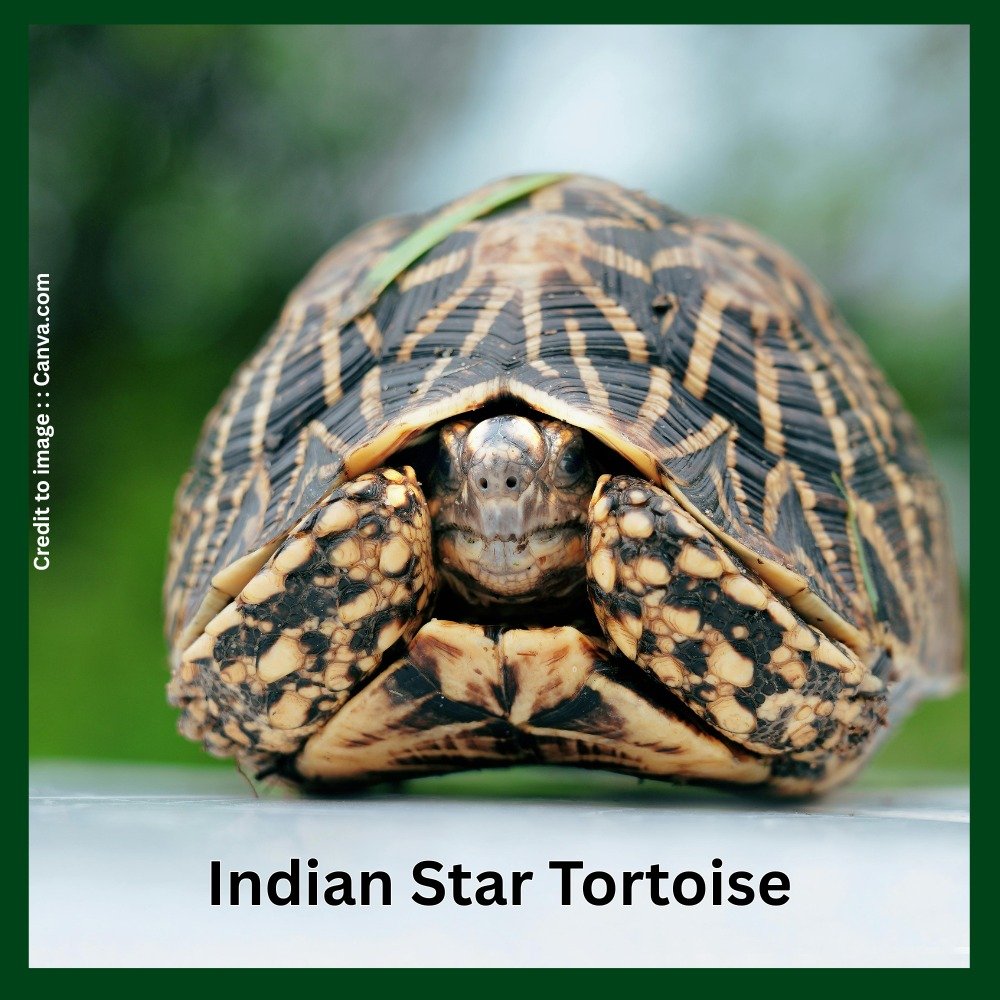
Habitat:
- Dry regions like thorn forests, grasslands, and semi-arid scrublands.
Distinct Features:
- Radiating Star Patterns: Light-colored lines from the center of each shell plate.
- High-domed Shell: Helps them flip back upright if turned over.
Behavior:
- Mostly solitary.
- Active during dawn and dusk.
- Hibernate or become inactive during extreme weather.
Conservation Issues:
- Illegal Trade: Highly sought after in Southeast Asia and the Middle East as a pet and for religious purposes.
- Habitat Fragmentation: Loss of native habitat due to agriculture and urban expansion.
Conservation Measures:
- Tortoise is Protected under Wildlife Protection Act, 1972 in India.
✅ Conclusion and Awareness
Both tortoises and turtles are fascinating reptiles that deserve awareness, respect, and protection. While the Indian Star Tortoise is native and culturally revered in India, species like the Red-Eared Slider pose threats to native biodiversity due to irresponsible pet ownership.
Mythology About Tortoise and Why People Keep Tortoises at Home
Tortoise in Mythology and Ancient Beliefs
The tortoise is not just a slow-moving reptile—it holds deep symbolic and mythological significance in many cultures across the world. From Hindu scriptures to Chinese legends, the tortoise is a powerful symbol of stability, wisdom, protection, and cosmic order.
🕉️ Hindu Mythology
In Hinduism, the tortoise plays a divine role in the cosmic order:
- Kurma Avatar:
Lord Vishnu’s second incarnation (Kurma Avatar) was in the form of a tortoise. According to the Samudra Manthan (Churning of the Ocean) story in Hindu texts, Vishnu transformed into a giant tortoise to support Mount Mandara on his back, which was used as a churning rod by the gods and demons.
👉 This symbolizes stability, patience, and divine support during cosmic struggle. - Vastu Shastra:
In Indian architecture and Vastu science tortoise is valuable. Tortoise is considered a sacred symbol of longevity, strength, and positive energy or more . Placing tortoise statues or figures in homes is believed to attract prosperity, harmony, and good health.
Chinese Mythology (Feng Shui)
In Chinese culture, the tortoise (often combined with a snake) is one of the Four Celestial Animals along with the dragon, phoenix, and tiger.
- It represents the north direction. Associated with protection, endurance, and wealth or more
- Feng Shui practitioners believe :
- Protect the home from negative energy.
- Promote career growth and wisdom.
- Brings stability and long and better life to the household.
African and Native American Folklore
- In some African traditions, tortoises are seen as clever and wise creatures, often appearing in stories as problem-solvers and survivors.
- Native American myths describe the world as being carried on the back of a Great Turtle, reflecting a view of the tortoise as the foundation of Earth and life itself.
Why Do People Keep Tortoises at Home?
People are drawn to tortoises not just for their unique appearance, but for the spiritual and symbolic benefits they are believed to offer.
1. Symbol of Longevity and Health
Tortoises are among the longest-living creatures on Earth. Keeping a tortoise or its symbol is believed to enhance health and ensure long life for household members.
2. Brings Peace and Harmony
Tortoises move slowly and calmly, and this behavior is often associated with peaceful energy, stability, and emotional balance within the home.
3. Attracts Wealth and Prosperity
In Feng Shui and Vastu, placing a tortoise figurine (especially made of crystal, metal, or jade) is said to attract financial stability, boost savings, and protect from financial risks.
4. Acts as a Protective Charm
Just like the tortoise’s hard shell protects it from threats, symbolic tortoises are believed to shield homes from evil eye, bad luck, and negative energies.
5. Encourages Wisdom and Patience
The slow and steady nature of a tortoise symbolizes persistence, patience, and intelligence—values that families wish to embody and pass on.
A Note on Real Tortoises as Pets : Wildlife Protection Act, 1972
While tortoise symbolism is positive, it’s important to not acquire wild or endangered tortoises as pets, especially species like the Indian Star Tortoise, which is protected under wildlife laws.
❗ In India, keeping native tortoises like the Indian Star Tortoise as pets is illegal under the Wildlife Protection Act, 1972.
✅ Responsible Alternatives:
- Use symbolic tortoise statues made from stone, metal, crystal, or wood for Vastu or Feng Shui purposes.
- Support conservation programs and wildlife sanctuaries instead of buying exotic or illegal pets.
Mythological Conclusion
The tortoise has journeyed through myths, temples, and households as a symbol of endurance, wisdom, and protection. Its role in sacred stories and spiritual traditions reflects humanity’s deep respect for nature’s balance and ancient life. Whether as a Vastu symbol or spiritual guide, the tortoise continues to inspire homes and hearts across generations.
10. Summary
Tortoises, though slow and ancient, are active contributors to their environments. Their ecological role, longevity, and vulnerability to human activities make them vital subjects of conservation and study. Protecting tortoises isn’t just about saving a species—it’s about preserving the ecosystems that rely on them. Their global presence, combined with local threats, requires both regional action and international collaboration.
11. Conclusion :12. FAQs :Tortoise Role in Biodiversity & Ecosystem
Tortoises are an irreplaceable part of Earth’s biological heritage. As biodiversity declines, the need to understand and protect species like the tortoise becomes critical. Research into their biology, behavior, and environmental role should be encouraged and supported. Let us work together—through conservation, education, and scientific publishing—to ensure these gentle reptiles continue to thrive.
12. FAQs :Tortoise Role in Biodiversity & Ecosystem
- What is the difference between a tortoise and a turtle?
Tortoises are land-dwelling with dome-shaped shells; turtles usually live in water and have flatter shells. - How long do tortoises live?
Many live over 80 years; some giant species can exceed 150 years. - Are tortoises endangered?
Yes, several species are endangered or vulnerable due to habitat destruction and poaching. - Do tortoises hibernate?
Some species, like the desert tortoise, hibernate during extreme weather. - What do tortoises eat?
Mostly plants—grasses, leaves, fruits, and flowers. - Can tortoises swim?
No, unlike turtles, most tortoises cannot swim and can drown in deep water. - Where are tortoises found?
Globally distributed across Africa, Asia, North America, and island regions. - Why are tortoises important for ecosystems?
They help in seed dispersal and soil aeration or maintain ecosystems . - How do tortoises reproduce?
They lay eggs in soil; the incubation period varies by species. - Can tortoises be kept as pets legally?
It depends on the species and local wildlife laws. Many are protected.
12. FAQs :Tortoise Role in Biodiversity & Ecosystem
- What is the oldest recorded tortoise?
Jonathan : a Seychelles giant tortoise age about 190 years old. - How can we protect tortoises?
Support conservation programs, avoid illegal pet trade, and preserve habitats. - Do tortoises have teeth?
No, but they have sharp beaks for cutting vegetation. - Are tortoises social animals?
Generally solitary, though some species may interact during breeding. - Can a tortoise feel its shell being touched?
Yes. The shell has nerve endings. But Sensitive to touch.
13. References
- IUCN Red List, 2024
- Convention on International Trade in Endangered Species (CITES), 2023
- U.S. Fish and Wildlife Service (USFWS)
- Seychelles Nature Protection Agency (NPA)
- World Wildlife Fund (WWF) Reports
- Herpetological Conservation Journal
14. Appeal to Researchers and General Public
We invite research scholars, wildlife ecologists, conservationists, and environmental enthusiasts to contribute their research papers, field reports, and review articles on tortoises and related herpetofauna to Prakriti Darshan – Nature and Environment Magazine (www.prakritidarshan.com).
Let your voice and data support biodiversity education and global conservation.
Together, let’s advocate for the protection of tortoises and all forms of life on Earth.
🌿 Join hands to protect nature—Submit your research to Prakriti Darshan today.
📩 For submissions and inquiries: prakritidarshan@gmail.com
PRAKRITI DARSHAN-NATURE AND ENVIRONMENT MAGAZINE
Prakriti Darshan is a leading Hindi-language magazine and digital platform dedicated to raising public awareness on vital issues related to nature, biodiversity, climate change, sustainable development, and environmental conservation. This magazine represents a unique blend of science, society, and sensitivity—offering a common platform for researchers, students, NGOs, policymakers, nature lovers, and conscious citizens alike.
With thought-provoking articles, inspiring stories, environmental research, impactful projects, and policy perspectives, Prakriti Darshan is a transformative journey toward a greener and more sustainable future.
Let us come together to protect and preserve our planet for generations to come. 🌿🌍
Join us in our mission to protect and celebrate the planet. 🌏💚
Click for more information
- Visit www.prakritidarshan.com for Free Magazine ,Free membership benefits ,offered price magazine @ Rs.1 or Rs.11 only and more ……
- 🎗️Sponsor Prakriti Darshan Magazine – Support our environment mission.
- 📚 Explore the Environment Magazine – Read our latest and past issues.
- ✍️ Read Editor’s Article or Blog – Insightful thoughts from our editorial desk.
- 🌱 Join Membership – Be part of India’s leading green community.
- 🤝 Become an NGO Impact Story Partner – Share your grassroots impact nationwide.
- 🏢 Become a Company Partner – Showcase your CSR, ESG, or sustainability work.
- 👤 Become an Individual Partner – Volunteer, write, and raise your green voice.
- 📢 Advertise with Us – Reach eco-conscious readers across India.
- Eco Trails Newsletter
- Donate for “Hari Ho Vashundhara & Har school Hariyali “ Plantation campaign Associated Partner NGO :GDSS NGO www.gdssngo.org
BALA DATT SHARMA,
MANAGING EDITOR ,
PRAKRITI DARSHAN-NATURE AND ENVIRONMENT MAGAZINE
- Drake Passage: The World’s Roughest Sea Route Between Atlantic and Pacific Oceans - August 22, 2025
- Top 10 Natural Parks in the USA: Biodiversity, Geography & Global Relevance - August 21, 2025
- Exploring the Best Natural Parks in USA: Biodiversity, Sustainable Tourism, and Role in SDGs - August 21, 2025


